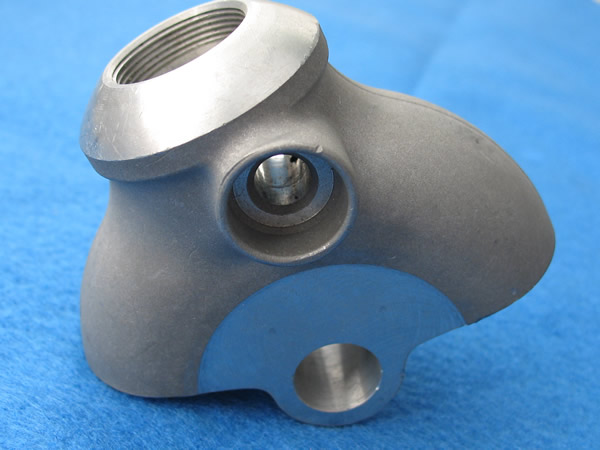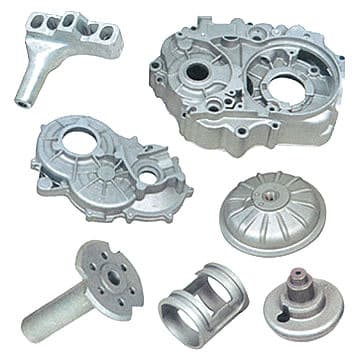How Aluminum Castings are recycled for efficiency
Exploring the Advantages and Techniques of Aluminum Casting in Modern Production
Aluminum casting has actually emerged as an essential technique in modern manufacturing. Its light-weight residential properties enhance energy performance and lower transport expenses. In addition, innovations in casting methods allow detailed styles and rapid prototyping. Nevertheless, the advantages expand past plain performance. The sustainability of aluminum casting processes offers significant implications for numerous markets. Understanding these aspects can expose the transformative influence of aluminum in modern production methods. What further innovations could redefine its function?
The Lightweight Advantage of Aluminum Casting
Aluminum casting provides a significant light-weight advantage that is changing industries reliant on durable yet convenient products. This home is particularly useful in industries such as auto and aerospace, where every ounce counts in performance and gas performance. The lowered weight of aluminum elements permits boosted handling, lower transport costs, and enhanced power efficiency during operation. Unlike heavier metals, aluminum provides a balance of strength and lightness, making it a perfect choice for complex applications that require high performance without sacrificing architectural integrity. Additionally, the deterioration resistance of aluminum expands the lifespan of cast parts, lowering the requirement for constant substitutes. This combination of lightweight features and longevity settings aluminum casting as a vital technology in modern production procedures, urging advancement and sustaining the growth of innovative products that meet the developing demands of different markets.
Enhanced Layout Flexibility and Complexity
Layout flexibility and complexity are markedly improved through using aluminum casting, allowing makers to create intricate shapes and forms that were formerly unattainable with typical techniques. This capability allows the production of elements with in-depth geometries, such as complex interior flows and thin-walled frameworks, which can especially improve the performance of the end product.
Additionally, aluminum casting methods, such as die casting and sand casting, facilitate quick prototyping, making it possible for developers to repeat and improve their ideas swiftly. The capacity to produce tailored mold and mildews likewise adds to far better alignment with specific style needs, decreasing material waste and lessening the requirement for considerable machining.
In addition, the lightweight nature of aluminum complements its style versatility, as it permits both visual charm and useful efficiency. On the whole, the innovations in aluminum casting offer suppliers with the tools to press the limits of design, promoting innovation across various sectors.

Superior Thermal and Electric Conductivity
Aluminum's premium thermal and electric conductivity makes it a necessary product in different manufacturing applications. Compared to other metals, aluminum offers considerable advantages, specifically in warmth dissipation and electric performance. Aluminum Castings. This building enables its prevalent use in sectors ranging from automotive to electronic devices, boosting general efficiency and reliability
Thermal Conductivity Advantages
A vital advantage of aluminum casting hinges on its superior thermal and electrical conductivity, making it an ideal option for numerous applications in modern production. The high thermal conductivity of aluminum permits efficient warmth dissipation, which is vital in markets such as automobile and electronics. Elements crafted from aluminum can effectively handle temperature level variations, prolonging the lifespan of items and improving performance. This attribute likewise enables makers to develop lightweight styles without endangering thermal performance. Additionally, aluminum's capacity to withstand thermal cycling even more strengthens its position in demanding settings. As sectors increasingly prioritize power efficiency and performance, the thermal conductivity advantages of aluminum casting become increasingly considerable in driving innovation and sustainability.
Electrical Conductivity Applications
The electric conductivity of aluminum complements its thermal homes, making it a beneficial product in various applications within modern production. This conductivity makes it possible for efficient power transfer, which is vital in electrical elements such as wiring, connectors, and circuit card. Aluminum's lightweight nature even more boosts its appeal in applications where reducing weight is important, such as in aerospace and automobile industries. Additionally, aluminum casting allows for the creation of intricate forms, maximizing the performance of electric devices. The material's resistance to rust and oxidation likewise contributes to durability in electrical environments, ensuring reliability. Overall, aluminum's premium electric conductivity settings it as a favored selection in markets that demand high efficiency and effectiveness in their electric applications.
Comparison With Other Steels
While aluminum is renowned for its remarkable thermal and electric conductivity, it is necessary to compare its residential properties with those of other steels to recognize its advantages totally. Copper, for example, exhibits also greater electric conductivity, making it more suitable in details applications like electrical wiring. Nevertheless, copper's weight and expense can restrict its use. In contrast, aluminum supplies a positive balance of conductivity, weight, and cost, making it excellent for several manufacturing applications. In addition, aluminum's thermal conductivity is generally premium to that of stainless-steel and titanium, which are commonly used in high-temperature atmospheres. Inevitably, his response aluminum stands apart not only for its conductivity but additionally for its lightweight and corrosion-resistant buildings, making it a versatile selection in contemporary production.
Cost-Effectiveness and Reduced Material Waste
Taking full advantage of cost-effectiveness and minimizing material waste are crucial advantages of aluminum casting in contemporary production. Aluminum's lightweight nature adds to reduce delivery costs and power consumption during production. Furthermore, its superb recyclability implies that scrap product created throughout the casting process can be reused, considerably decreasing the overall material prices.
Furthermore, aluminum casting methods usually permit complex forms to be generated with less additional procedures, which streamlines the manufacturing procedure and reduces labor expenditures. The capacity to create precise parts decreases the requirement for too much machining, additional lessening waste.
Business embracing aluminum casting gain from minimized production time and enhanced efficiency, leading to total price financial savings. This mix of lower material expenses, reliable reusing methods, and reliable manufacturing procedures settings aluminum casting as an economically beneficial choice in the affordable landscape of contemporary production.
Advancements in Aluminum Casting Techniques
Recent advancements in aluminum casting strategies are transforming the manufacturing landscape. Innovations such as the assimilation of additive manufacturing, enhanced mold and mildew designs, and environmentally friendly casting procedures are driving effectiveness and sustainability. These developments not just enhance product top quality however also minimize environmental influence in the aluminum casting market.
Additive Production Assimilation
Additive manufacturing is transforming aluminum casting techniques by allowing the production of complicated geometries and light-weight frameworks that were useful source formerly unattainable. This combination permits producers to leverage 3D printing modern technologies to create detailed molds and cores, which assist in the casting of detailed layouts with enhanced precision. In addition, additive manufacturing lowers product waste and reduces lead times, making it a much more lasting and efficient technique. Therefore, business can react more quickly to market needs and customize products to satisfy details customer demands. This harmony in between additive manufacturing and aluminum casting not only improves layout versatility yet also positions makers to introduce continuously, driving improvements in performance and item performance within the competitive landscape of modern manufacturing.

Boosted Mold And Mildew Style
As makers look for to directory improve effectiveness and item top quality, innovations in mold layout have actually become a critical element in contemporary aluminum casting strategies. Advanced mold and mildew products, such as silicon carbide and graphite, boost thermal conductivity and durability, permitting faster cooling and boosted surface finishes. The integration of computer-aided design (CAD) innovation enables accurate mold geometries, facilitating intricate forms that were formerly challenging to achieve. Innovations like 3D-printed mold and mildews additionally give fast prototyping abilities, decreasing lead times substantially. In addition, modular mold designs enable less complicated modifications and repair services, reducing downtime during manufacturing. Collectively, these enhancements not just simplify producing processes but additionally add to the overall quality of aluminum actors items, meeting the evolving demands of numerous markets.
Eco-Friendly Casting Processes
While the aluminum casting industry continues to progress, a growing focus on sustainability has brought about the advancement of environment-friendly casting processes. These cutting-edge techniques intend to decrease ecological effect by decreasing waste and energy intake. One noteworthy strategy includes making use of recycled aluminum, which significantly decreases the carbon footprint associated with basic material removal. Additionally, developments in mold and mildew products and designs enable for more effective warmth transfer, decreasing power requirements during manufacturing. Water-based finishings and binders change traditional solvents, furthermore lowering harmful discharges. Some manufacturers are embracing closed-loop systems, making certain that waste materials are reused within the production cycle. Jointly, these environment-friendly casting processes not just improve sustainability yet also add to an extra responsible production landscape.
Sustainability in Aluminum Casting Processes
Sustainability in aluminum casting procedures has actually become a centerpiece for makers intending to lower their environmental impact. The market is progressively taking on methods that minimize waste and enhance resource efficiency. One significant method involves making use of recycled aluminum, which needs only a fraction of the energy needed to generate brand-new steel from ore. This not just preserves sources yet additionally reduces greenhouse gas emissions associated with production.
Moreover, developments in innovation have resulted in more energy-efficient casting approaches, such as low-pressure and gravity casting, which enhance material use and reduce power intake. Suppliers are likewise carrying out closed-loop systems that enable the recycling of scrap material created throughout the casting process. Additionally, using eco-friendly layers and lubricants better adds to a more lasting operation. Generally, these campaigns mirror a dedication to ecological stewardship while preserving the quality and performance of aluminum casting
Applications of Aluminum Casting Throughout Industries
Aluminum casting finds considerable applications across different sectors because of its light-weight, stamina, and flexibility. In the auto market, aluminum castings are utilized to generate engine blocks, transmission housings, and wheels, improving fuel performance while decreasing exhausts. The aerospace industry makes use of aluminum spreadings for structural parts, benefiting from their high strength-to-weight proportion, which is vital for flight safety and security and performance.
In the customer electronic devices industry, aluminum spreadings are made use of for housing and architectural parts, offering durability and aesthetic allure. Additionally, the building sector leverages aluminum castings for architectural elements and components, capitalizing on their resistance to rust.
The aquatic market includes aluminum spreadings in boat frames and engine parts, mirroring its viability for harsh atmospheres. Overall, the diverse applications of aluminum casting underscore its value in contemporary manufacturing, adding to advancement and effectiveness throughout different areas.
Frequently Asked Questions
What Are the Typical Alloys Used in Aluminum Casting?
The common alloys used in aluminum casting include 413, 356, and A380. These alloys are valued for their exceptional fluidity, stamina, and rust resistance, making them suitable for various applications in production and engineering.
Just How Does Aluminum Casting Compare to Other Casting Methods?
Aluminum casting offers special advantages over various other casting methods, such as lighter weight, excellent rust resistance, and premium thermal conductivity. It likewise permits intricate styles and faster manufacturing times contrasted to traditional products like iron or steel.
What Is the Common Lifespan of Aluminum Cast Products?
The regular life expectancy of aluminum actors items varies, typically ranging from 20 to half a century, relying on elements such as ecological problems, upkeep, and specific applications. Appropriate treatment can substantially prolong their sturdiness and efficiency.
Are There Any Kind Of Wellness Threats Related To Aluminum Casting?
The question of wellness risks connected with aluminum casting develops due to possible exposure to aluminum dirt and fumes. Extended inhalation might cause respiratory problems, emphasizing the value of proper precaution during the casting procedure.
How Can Issues Be Lessened in Aluminum Casting?
To minimize flaws in aluminum casting, manufacturers can carry out stringent high quality control steps, enhance mold styles, keep proper temperature control, make use of suitable alloy make-ups, and use effective cleaning techniques to assure a defect-free casting process.